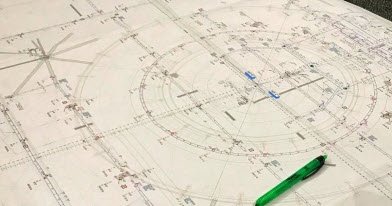
Using a scale ruler to measure and mark drawings with needed measurements is an important skill to master for anyone working on technical drawings.
Open FormTranscript.
So on the scale ruler worksheet, we’re going to take our scale ruler. For those of you that have this one here, we have your 1″ scale, 1/2″ scale and 1/4″ scale. There are different scales on this piece of paper. We’re going to fold this over so that we have a nice straight edge along the top of the 1″ scale. And we line up our paper like so to the zero on one end on the 1″ scale.
It’s going to go from zero to five foot and six inches, so this line here is five foot six inches long. Now, if we take a regular ruler and we find the one inch scale right here, we put this down on the paper. And we start at the zero and we have five feet, and then it goes to between five feet and six feet, so that would be five foot six inches. Now, another way of using this triangular scale rule is instead of doing this, this is really obvious because it’s to the six inch mark.
We put the five foot here on the end. And we go back to the zero, so that’s five feet there, and then we look at the inches and it lines up to the six inches, which is on the one inch, the individual lines here for the for the inches. So you really need to have your your real scale rulers by the time you get back into the paper, well, doesn’t cut it for the class, but for this worksheet it’ll work in this particular example, doing the paper on paper, the accuracy of the paper, one because the lines are as thick as they are, is not as great as we’d like it.
The accuracy of this plastic one is better. And if we take a really close look at this line and we line it up right at the end, we see that according to the plastic ruler, this thing is five feet, six and a quarter inches long. According to this, and when we’re dealing with one in scale, we can get that accurate, especially when you’re using a nice sharp pencil, the width of your pencil in scale makes a difference when you’re drawing your lines.
So that’s one in scale. If we move to 1/2″ scale, we use the other end of the scale ruler. And in this case, the closest line here I would put this is zero. We get to a six there. We move this over. So the six is on the end of the line, 6′-0″, and then one to about two and a half. So that’s 6′-2 1/2″ in scale.
So when you’re drawing your dimension lines and when you do this problem, you need to start concentrating on your dimension lines. So I’m going to take my triangle and draw a little tic line there and the line here. Draw a line from one end to the other with a little bit of an arrow. So I take my paper scale over. I folded a half inch edge so I can get in there nice and tight. Six feet there, move over and on the paper, one is six foot three.
So I’m right down here, six foot three, six feet, three inches. And when you’re writing down your dimension, you want to follow the protocol or the nomenclature because using in the dimensions chapter and that’s how you fill it in. And I’d like you to get in the practice of using a ruler. So you have a nice straight edge, a nice straight line on these dimension lines. You might as well get into practice. Now, if you want to make a copy of this and do your measurements, you know, if you’re on spring break, just do the measurements so you have them and then come in and draw them. That’s fine Measurement, same measurement here to the bottom. So I’m going to take a vertical line here and move over a line over here. And then draw my horizontal. Little arrows here, and then you’re going to write your five foot. Six inch mark in there, along with the apostrophe and the quotation marks, the feet and inches. So that’s nice and clean and the ends want to go all the way to the end. So as you’re doing this project, you can even draw all these lines first and then fill them in later.
You don’t need to do the line and measuring at the exact same time if you don’t want to. Square line there. And then you’ve got your measurement line should be a little bit more in the middle, but there it is. And your verticals for the vertical measurement on this one. And then add the measurement. So that’s how you’re going to do your worksheet and I encourage you to use your straightedge.
Read more about hand drafting here: https://eventdrawings.com/hand-drafting/
